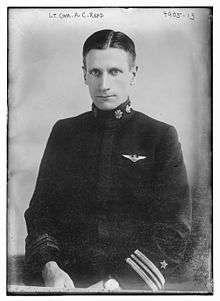Albert Cushing Read
Albert Cushing Read, Sr. (April 29, 1887 – October 10, 1967) was an aviator and Rear Admiral in the United States Navy. He and his crew made the first transatlantic flight in the NC-4, a Curtiss NC flying boat.[1]
Albert Cushing Read, Sr. | |
|---|---|
 Read in 1919 | |
| Born | April 29, 1887 Lyme, New Hampshire |
| Died | October 10, 1967 (aged 80) Coconut Grove, Florida |
| Place of burial | |
| Allegiance | |
| Service/ | |
| Years of service | 1907–1946 |
| Rank | |
| Battles/wars | World War I World War II |
| Awards | Distinguished Service Medal Legion of Merit NC-4 Medal |
Early life and Atlantic crossing
Read was born in Lyme, New Hampshire on April 29, 1887 into a Boston Brahmin family. He attended the United States Naval Academy at Annapolis, graduating in the class of 1907. In 1915, he was designated naval aviator number 24.
As a Lieutenant Commander in May 1919, Read commanded a crew of five on the NC-4 Curtiss flying boat, the first aircraft ever to make a transatlantic flight, a couple of weeks before Alcock and Brown's non-stop flight, and eight years before Charles Lindbergh's solo, non-stop flight. Read's flight started from Rockaway Beach, Long Island, took 23 days before arriving in Plymouth, England. The six stops included layovers at Trepassey Bay, Newfoundland, the Azores, and Lisbon, Portugal.
Later in 1919, upon returning to the U.S., Read predicted: "It soon will be possible to drive an airplane around the world at a height of 60,000 feet and 1,000 miles per hour." The next day, The New York Times ran an editorial in reaction, stating: "It is one thing to be a qualified aviator, and quite another to be a qualified prophet. Nothing now known supports the Lieutenant Commander’s forecast. An airplane at the height of 60,000 feet would be whirling its propellers in a vacuum, and no aviator could live long in the freezing cold of interstellar space."
On June 3, 1919, he was made a commander of the Order of the Tower and Sword by the Portuguese government.[2] In 1929, Read and the rest of the flight crew of NC-4 were awarded Congressional Gold Medals.[3]
Later life
Read trained naval aviators through World War II. He was nicknamed "Putty Read" because his face rarely showed any emotion.[4]
On June 4, 1962, he appeared on the TV game show I've Got a Secret.[5]
He died in retirement in Coconut Grove, Florida, on October 10, 1967.[1][6] He was buried in Arlington National Cemetery.[7] He was married to Elizabeth Anderson “Bess” Burdine (September 16, 1896 – December 8, 1992).[8]
Awards
References
- "Adm. Albert C. Read Dies at 80. First to Fly Across the Atlantic". The New York Times. October 11, 1967.
- "Ordens Honoríficas Portuguesas" [Portuguese Honorary Orders]. Presidency of the Portuguese Republic (in Portuguese). Retrieved 2018-04-14.
- "A Congressional Gold Medal awarded to the crew of the first transatlantic flight". artandhistory.house.gov. Archived from the original on 2012-09-16. Retrieved 2012-09-17.
- Century of Flight: The Atlantic Challenge
- "Year 1962". 2009-03-03. Retrieved 2016-08-09.
- Cunningham p. 153.
- "Albert Cushing Read". Find a Grave. Retrieved September 3, 2010.
- "Read, Bess B". Arlington National Cemetery. Retrieved 2018-04-14.
Bibliography
- Cunningham, Charlie and Jackie. Putty and Bess. Alexandria,VA: Association of Naval Aviation, 1997.
- Albert Read on Arlington Cemetery site
- Albert C. Read and the NC-4 on early aviators site
- Commander Albert C. Read is congratulated by Secretary of the Navy Josephus Daniels and Assistant Secretary of the Navy Franklin Delano Roosevelt(standing on right) on June 30, 1919
| Wikimedia Commons has media related to Albert Cushing Read. |